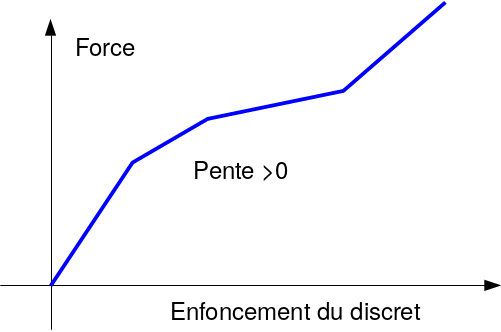Behavior DIS_CHOC_TRAC#
Definition#
Behavior DIS_CHOC_TRAC is an elastic nonlinear behavior that applies to the local DX degree of freedom of discrete elements with two nodes (mesh SEG2)
The non-linear behavior is given when defining material DIS_CHOC_ELAS by a \(F=\mathit{fonction}(\mathrm{\Delta }U)\) curve:
\(\mathrm{\Delta }U\) represents the relative movement of the 2 nodes in the element’s local coordinate system.
\(F\) represents the effort expressed in the element’s local coordinate system.
Data setting#
Nonlinear function#
A necessary data is the function describing the non-linear behavior. This function must meet the following criteria:
It is a function in the sense of code_aster: defined with the operator DEFI_FONCTION,
The interpolations on the x-axis and the y-axis are linear,
The name of the abscissa when defining the function is DX,
Extending to the left is excluded,
The extension to the right of the function is either excluded or linear,
The function must be defined by at least 2 points.
The first point is \((\mathrm{0.0,}0.0)\) and must be given,
The function must be strictly increasing,
The first two points of the function are used to define the elastic slope to the behavior. The x-axis and ordinate units should be consistent with those of the problem:
the abscissa must be homogeneous when displaced,
the ordinate (value of the function) must be homogeneous to an effort.
Definition of contact distance#
++————————————————————————————————————————————————————————————————————————–+ ||In the case of a discrete with 2 knots: \(\mathit{DistanceContact}=\mathit{LongueurDiscret}–\mathit{dist}1–\mathit{dist}2\) The contact distance is positive in the direction of the local axis \(\mathit{Xloc}\).| ++————————————————————————————————————————————————————————————————————————–+
In the case of a discrete with 2 knots (based on a SEG2).
Let’s say two structures \({\Omega }_{1}\) and \({\mathrm{\Omega }}_{2}\). Note \({d}_{N}\) the normal distance between structures, \({F}_{N}^{1/2}\) the normal reaction force of \({\mathrm{\Omega }}_{1}\) over \({\mathrm{\Omega }}_{2}\).
In the coordinate system local to the element, the normal distance \({d}_{N}\) is expressed as:
\({d}_{N}=(({X}_{\mathit{loc}2}^{0}+{u}_{2})–({X}_{\mathit{loc}1}^{0}+{u}_{1}))–{\mathit{dist}}_{1}-{\mathit{dist}}_{2}\).
There will be « shock » when \({d}_{N}\le 0\)
The depression of the discrete will therefore be \(\Vert {d}_{n}\Vert\) and the effort will follow the given behavior curve.

Function: Contact force vs indentation#